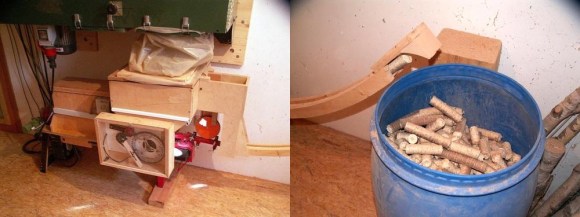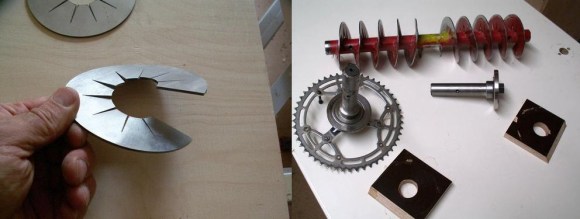
[Alois Schmid] is an avid woodworker, and as such, he makes a lot of saw dust. Unfortunately, saw dust is kind of wasteful — it doesn’t burn very well unless it is compressed… so he built his own wood briquette press!
He originally looked at purchasing a machine designed for this, until he discovered they run upwards of 10,000 Euros. You could buy an amazing CNC mill for that! Needless to say, it was out of the question.
He started by purchasing a new more efficient dust extractor and an electric log splitter, and then he built an ingenious feeder system. He’s replaced the log splitter blade with a long metal dowel with a protrusion at the end (helps keeps the briquettes in one piece), which is slightly smaller than the compression tube he’s built.
The really cool part of this build is his home-made auger system. He’s cut out metal donuts from sheet metal and cut notches around the inside diameter — he then bent them into a semi-spiral, and welded a whole series of them onto a metal bar.

To prevent the wood chips from bridging over the auger, he’s also made wooden gears that simply follow the top of the auger — he’s really thought of everything! All in, the project cost a bit shy of 1000 Euros — still a pricey investment, but well worth it considering the amount of wood he goes through — and at 10% of the cost of a commercial offering, we think he’s done a pretty good job!
The project is definitely worth a read, and you should also check out his drool-worthy workshop!
[Thanks Joe!]















Compressing the wood takes a surprisingly large amount of energy. The barrel of briquets is worth about 200 kWh of energy when burned, or less depending on burner efficiency, so it takes nearly 10% of the energy contents of the wood to process it.
90% efficiency in recycling is pretty high.
Not really, considering the wood chips could be burned as such in a suitable burner. If you consider it an energy source, the EROEI is pretty crappy.
Commercial pellet mills can process 500-800 kilograms of material per hour on 22 kW of input power.
If the heating value of the pellets is 4 kWh per kilo, then the energy efficiency is at least 99%
Yeah, but that’s not factoring in the cost of hauling the stuff to the nearest commercial pellet mill and then hauling the pellets back. It’s like no matter what you do Rudolf Clausius is just going to come and kick you in the crotch anyway.
Presumably the compressing-mill itself gives off heat in operation, from the motor, friction in the mechanics, and maybe even from the compression. I wouldn’t suggest running it through a heat exchanger to the house’s boiler, but it’ll at least heat up his workshop, or whatever room he’s doing it in.
It’s the handy advantage of heaters… all energy ends up as low-grade heat whether you like it or not, eventually. So making a room a few degrees warmer is a game it’s difficult to lose at.
That is, if you’re stuck with burning things, rather than using heat pumps, which can have efficiencies of something round 800% for making heat from electricity. Even in cold ground, assuming it’s significantly above 0K outside.
Even long distance transport and distribution of pellets, e.g. from Canada to the US only takes up about 14% of the energy contents of the pellets. Local collection and distribution is quite efficient. A 22 kW pellet mill can deal with wood chips, dry lawn clippings, raked leaves etc. and compress everything into pellets roughly equivalent in heating value, so if you did want to have one, a communal pellet mill would make perfect sense.
The heat given off by this small system is wasted heating a side room that is quite likely not heated in the first place and not in continuous use by people.
Cost of hauling it? There’s going to be a cost of hauling the sawdust no matter what. Lumber mills have to get rid of it somehow, so either it’s going to be hauled to a landfill, or made into particleboard, pellets, etc. Even if it’s proccessed on site (which is rare), it’s going to be transported as a finished product. They’re not just going to have moutains of sawdust out back.
Sweet, Presto Logs. Will three of them make a train to 88 Miles Per hour?
Only if you soak them in colorfulpaint…
This looks like one of those all encompassing, hugely time consuming projects that I would labor over for years and years with almost no reward. Then finally, one day I turn it on and it runs all by itself, producing useful wooden pellets out of otherwise waste. I can sit back and marvel at my own ingenuity and my skills as a craftsmen. But now that it is complete I feel something. It is an emptiness, a hollow feeling where something wonderful used to be but is now missing. I have become saddened by this machine that was supposed to bring me joy. Desperately trying to recapture the magic I look for ways to improve it, little modifications to make it that much better, but no. It is not the same anymore. The joy has left it. One day, months later, sitting at my workbench I notice something, something just not quite right. Its at the other side of my workshop from the wood briquette press. Its something that could be better, NO! it is something that will be better. I have a now have a new project. All is right in the world.
Enter the phrase, “The journey is the destination”.
sums up Home Automation!
I just finished scratch building a guitar amplifier and I must say I feel exactly this way.
Yes, exactly the my experience also-the fun of a project is actually the journey on
the way to the end- the actually end is actually an anti-climax. Another thing is that
no matter how revoltionary the project might appear at the outset, once completed-it
will just appear as a logical stepping stone, an incremental step- mundane.
But such is life and engineering !
Here’s to the next project!
Saw dust, also known as wood dust, contains a chemical known to the
State of California to cause birth defects or other reproductive
harm.
Well, don’t eat it, then.
Or breathe in the fumes as it burns…. oh, wait! I suppose they’re ugly looking little bits of scrap, so you wouldn’t want them on your log fire anyway. A sealed boiler should keep the smoke away from you. Although how the chemicals will affect the high-tech cleverly-designed chimney and combustion chamber, who knows?
It’s a pisser, nowadays. You can’t just buy wood! You can buy cellulose-based construction sheets, or forest-generated organic combustibles, but actual WOOD that does both, nobody sells! I suppose on one hand, the “wood” we have now is better suited for it’s intended job. But it limits ingenuity when you’re thinking of clever ways to re-use waste.
I knowa good friend that has a huge wood lathe and turns gigantic bowls and staircase spindles and candle holders and russian stacking dolls, you name it, etc, he also makes all sorts of other wood projects and never buys any wood… He simply goes out in the woods (imagine that) and picks it up off the ground. That or other people he knows give him interesting chunks they find in their wood pile that would normally end up burnt in the stove, or when they havea tree fall on their property. But aside from that, you have still go to specialty stores for woodworkers and buy wood, or to saw mills even. You must live in the city where they only place to buy wood is the big box hardware stores?
I think it depends on the source wood, no? If it’s been treated with chemicals and all that? I don’t think there’s anything inherently harmful in sawdust otherwise, unless wood and, ultimately, trees themselves are. Does anybody know for sure?
The only wood I’m aware of with a chemical in it is pressure treated lumber which is used outdoors. It’s unlikely that the woods he’s using contain those poisons.
More likely he’d have lung problems from inhaling dust unprotected.
Plywoods may contain Formrldahyde (anti rot preservative I believe). The are green options available, I believe NAUF (non added urea formeldahyde) is what you want. Most hardwoods used in woodworking are just plain wood. Treated lumbers are usually only for outside structures and ground contact applications. (I’m not sure what those are actually treated with)
I used to work IT at a cabinet factory.
Also you wouldnt want to be burning plywood waste anyways, as the glues residue in the exhuast can build up and clog your flue.
Californians – they think everything is a hazard to something.
When, oh when, will they realize that they are the true hazard to the rest of civilization?
Did you ever notice that things are only carcinogenic in California? Something in the water perhaps?
Something in the law. Everywhere else companies are allowed to poison you and not mention it.
Stay out of California then ;)
This is nonsense. Wood dust is wood. This is as harmless as just burning normal wood.
Which isn’t harmless.
The State of California, also known as California, contains chemicals known to the
State of California to cause birth defects or other reproductive harm.
So does Oxygen.
(No, really, it’s written on the gas bottles)
You CAN easily burn raw sawdust. You just need a rocket stove, which isn’t that hard to build:
https://www.youtube.com/watch?v=odK33HlcAAs
Just a PSA – I wasted an ENTIRE work day on that website… It’s absolutely fascinating to say the least.
That panel is really nicely done, industrial spec.
Anyone know what controller he is using? There’s a Siemens supply and what appears to be a Siemens controller but it’s not like any conventional PLC I’ve seen.
It’s a LOGO, Siemens’ low end PLC. Usually 10 input, 4-10 output.
Thanks!
Wow. Kudos to the builder. That’s a really nice setup. Had considered similar in the past but never with such completeness, detail and function. Very nice.
You made a great point about how you can use a dust extractor and log splitter to get sawdust for fuel. My husband and I are looking for a sawdust supplier to help us keep our fireplace filled. We will keep these tips in mind as we search for a professional that can help us best.